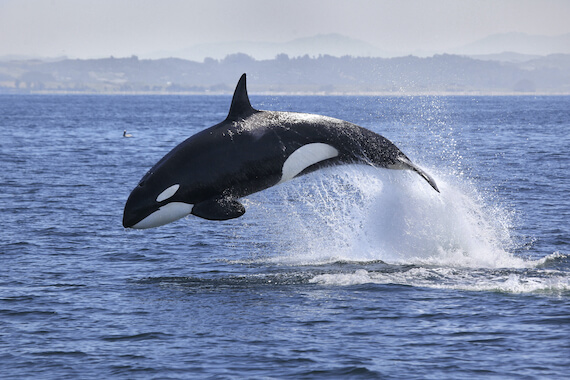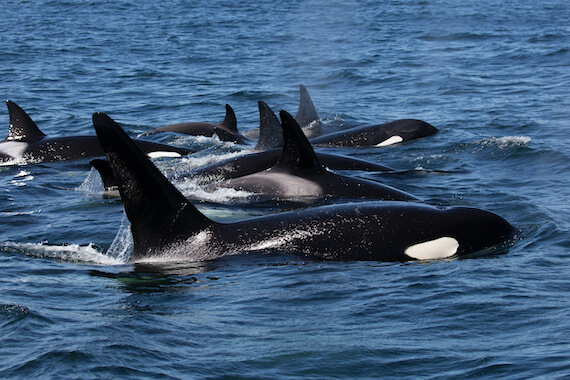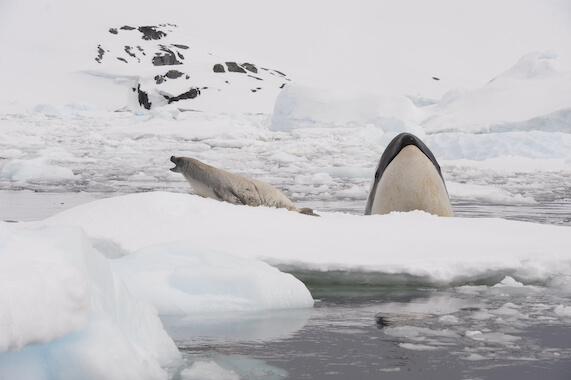
| Kingdom | Animalia |
| Phylum | Chordata |
| Class | Mammalia |
| Order | Artiodactyla |
| Infraorder | Cetacea |
| Family | Delphinidae |
| Genus | Orcinus |
| Species | Orcinus orca |
| Niche | Carnivorous cosmopolitan marine mammal |
| Length | 23 – 32 feet (7 – 9.7 meters) |
| Weight | 6 – 11 tons (5,443 – 9,979 kg) |
| Lifespan | 50 – 90 years |
| Social Structure | Matrilineal family groups |
| Conservation Status | Data Deficient |
| Preferred Habitat | Temperate coastal waters |
| Average Number of Offspring | 1 |
| Main Food Item | Fish, cephalopods, mammals, seabirds, & sea turtles |
| Predators | None |
The Basics
The killer whale, or orca, is a carnivorous marine mammal found throughout the world’s oceans. It is the only species in the genus Orcinus. Despite its name, the killer whale is not actually a whale and is instead the largest member of the dolphin family. The distinctive colouration of killer whales is thought to provide camouflage when hunting. This is because when viewed from above, the black backs of these animals blend in with the dark ocean waters, whereas from below their white stomachs blend in with the bright surface waters.
Killer whales are distributed from polar regions to tropical regions and can be found in all of the world’s oceans and seas except the Baltic and Black seas. Having said this, killer whales do show a preference for cooler water in shallow coastal areas. Due to their huge range, it is difficult to accurately estimate killer whale population parameters such as size, density and relative distribution.
Killer whales have an extremely varied diet including fish, cephalopods, mammals, seabirds and sea turtles. They are also the only known predator of great white sharks. In temperate regions, different populations might show specialized foraging behaviours and diets. However, in tropical regions with lower productivity, populations tend to have more generalized diets. Nevertheless, the average killer whale needs to eat around 500 pounds (227 kg) of food per day.
After a gestation period of 15 – 18 months, female killer whales give birth to a single calf. All male and female pod members participate in caring for young. But even so, the mortality rate for calves is extremely high within the first 7 months of life, during which time 37 – 50% of all calves die. Weaning begins at 12 months of age and calves are typically independent by 2 years old. In certain killer whale populations, individuals remain with the pod they were born into their entire life, whereas in other populations juveniles eventually go their own way.

Ecotypes
Multiple distinct populations of killer whale have been identified around the world based on differences in morphology and behaviour. It has been suggested that at least some of these populations should be recognised as separate species.
In the northeast Pacific ocean, three main ecotypes have been identified:
- The resident ecotype is the most commonly sighted ecotype in coastal waters and feeds primarily on fish. Individuals of this type associate in large, complex pods made up of family members. They also communicate using complex dialects and visit the same areas consistently.
- The transient ecotype feeds almost exclusively on marine mammals and travels in small groups of up to six animals. Individuals of his type exhibit weaker family bonds, communicate using less complex dialects and range over large distances along the west coast of America.
- The offshore ecotype is found in open water far from shore and feeds primarily on schooling fish. Individuals of this ecotype associate in large groups of 20 – 75 animals and are smaller than the other two ecotypes.
In the Antarctic ocean, four main types have been identified:
- Type A looks like a typical killer whale. This type migrates to Antarctica during the austral summer, where it feeds mainly on minke whales in open waters.
- Type B is characterized by a large eye patch and is dark grey rather than black. This type forages mainly in loose pack ice, feeding on seals. Its white parts are tinged yellow due to the presence diatom algae in Antarctic waters.
- Type C has a colouration similar to type B, but its eye patch is smaller and slanted forward. This type is the smallest killer whale known and forages deep in the pack ice, where it feeds exclusively on fish.
- Type D has typical killer whale colouration and is characterized by a tiny eye patch. This type is distributed in subantarctic waters at all longitudes and is thought to feed mainly on fish.
Fun Facts about Killer Whales
Killer whales are highly intelligent social mammals that demonstrate a number of interesting behaviours and provide examples of several important biological concepts.
Keep it in the Family
Killer whales are highly social animals and typically live in complex social groups comparable to those of higher primates and elephants. Although living in groups has a number of costs including increased competition and disease transfer, it also confers several benefits such as social foraging, group vigilance and cooperative care of young. In social species such as the killer whale, these benefits outweigh the costs, making group living selectively advantageous for individuals.

Killer whale social groups are matrilineal, consisting of the eldest female and her offspring, in addition to her daughters’ offspring and so on. Given that killer whales can live up to 90 years, as many as four generations can be found in the same group. These groups are highly stable with very strong bonds and individuals are rarely seen apart for more than a few hours at a time. Two to four closely related matrilineal groups often join to form larger aggregations called pods, which in turn join to form even larger aggregations called clans, in which all individuals share similar vocal dialects.
The Wolves of the Sea
Killer whales typically hunt in cooperative groups like wolves, which has earned them the nickname the wolves of the sea. Cooperative hunting is a technique commonly used by social carnivores and is thought to confer a number of selective advantages. For example, hunting in groups permits larger prey species to be caught and allows protection of kills from scavengers. Furthermore, pack hunting can be useful for separating mothers from their young, for confusing prey and for capturing gregarious prey swiftly before individuals scatter.
Individual killer whale pods often specialize in catching a specific prey type and use innovative cooperative hunting techniques to do so. For example, certain populations of killer whale use a wave-hunting technique to catch seals and penguins floating on small chunks of sea ice. This technique involves several killer whales swimming together to create waves that wash prey off the sea ice and into the water where other killer whales lie in wait. Other populations of killer whale use a beaching technique, in which they throw themselves out of the water onto beaches to attack prey such as sea lions and elephant seals, before wriggling back into the sea.

Intelligence
Killer whales have the second heaviest brains among marine mammals and demonstrate a number of behaviours that convey their intelligence. For example, these animals live in complex social groups, each with a unique culture. It has been shown that different matrilineal groups of killer whales communicate using distinct dialects, which individuals likely learn from other members of their group. Similarly, mothers have been found to teach skills to their young, pushing calves onto beaches to help them practice the beaching hunting technique, for instance. Killer whale hunting techniques in themselves also demonstrate a significant level of intelligence, with certain populations even having learnt how to steal fish from fishing lines.
